The Philippine peso is the official currency of the Philippines. There they call it “piso” or “pisos”. Its ISO 4217 code is PHP and its symbol is ₱. The Philippine peso is divided into 100 centimos (“sentimos” in Tagalog).
Compare rates at 80 currency stores in 34 cities
The peso is the name of other world currencies such as the Argentine peso, Chilean peso, Colombian peso, Dominican peso, Mexican peso or the Uruguayan peso.
As of the date of this update, July 5, 2023, the equivalence of the Philippine peso currency with respect to the euro is:
- 1 euro = 60.40 Philippine pesos.
- 100 pesos = 1.65 euros
History of the Philippine peso
Before colonial times (the Spanish arrived in the Philippines in 1521), Filipinos had trade relations with neighboring territories such as China, Java, Borneo, Thailand, and other settlements.
Barter was the prevailing system in all these commercial exchanges, followed later by the exchange and acceptance of sea shells (cowry shell money), accepted as a means of payment in large parts of Asia, Africa and America.
Compare rates at 80 currency stores in 34 cities
Later, precious metals and stones such as gold, jade, quartz or wood became the most common and accepted form of money in the Philippines, rich in gold. This gave rise to the bartering of raw materials and manufactured goods for pure gold “barter rings” made by hand by early Filipinos between the 11th and 14th centuries.
Already in the colonial era (1521-1897), the Philippine peso was created and developed, based on the “Real de a 8” of Spain and the Mexican peso. These coins spread throughout the Americas and Southeast Asia at the height of the Spanish Empire. Hence, so many Latin American coins and this one from the Philippines bear the name “peso”.
In the 19th century, the former American colonies from Spain began to gain independence, issuing silver coins with revolutionary mottos and symbols that also reached the Philippines at the end of the century. Spanish government officials on the islands feared that the seditious markings would incite Filipinos to rebellion.
Therefore, they removed the inscriptions by stamping the coins with the word F7 or YII. The silver coins with the profile of the young King Alfonso XIII were the last coins minted in Spain. The “peso fuertes”, issued by the country’s first bank, El Banco Español Filipino de Isabel II, were the first paper money circulated in the Philippines.
This issue of Philippine pesos began in May 1852, although the coins would arrive years later, in 1861. It was in 1864 when the Philippine peso was divided into 100 cents.
Between the years 1900 and 1941, with the arrival of the Americans in 1898, modern banking, monetary and credit systems were instituted, making the Philippines one of the most prosperous countries in East Asia. The Philippine monetary system was based on gold, pegging the Philippine peso to the US dollar at a ratio of 2:1. The United States Congress passed the Philippine Currency Act in 1903.
Coins issued under the system bore the designs of the Filipino engraver and artist, Melesio Figueroa (1842-1903). Coins of denominations of half a cent and one peso were minted.
The name change from El Banco Español Filipino to Banco de las Islas Filipinas in 1912 paved the way for the use of English instead of Spanish on all banknotes and coins issued until 1933.
Then came 4 years of Japanese occupation, between 1942 and 1945 in World War II in which pesos and yen were handled. And finally, with the Philippine independence from the US at the end of the war, the Central Bank of the Philippines was created in 1949 (today it is known as the Bangko Sentral ng Pilipinas or BSP).
The first pesos were notes printed by Thomas de la Rue & Co., Ltd. in England and coins minted at the US Bureau of Mint. The “Filipinization” of the Republic’s coins and paper money began in the late 1960s and continues to the present.
In the 1970s, Ang Bagong Lipunan (ABL) series banknotes circulated, which were printed at the Security Printing Plant starting in 1978. A new wave of change swept through the Philippine currency system with the coins of flora and fauna initially aired in 1983. This series featured national heroes and local flora and fauna species of the Philippine islands.
The new design series of banknotes issued in 1985 replaced the ABL series. Ten years later, a new set of coins and banknotes bearing the logo of the Bangko Sentral ng Pilipinas was issued.
Philippine peso coins
The Philippine peso has coins of cents (they call them “sentimo” there) and pesos with these denominations or face values:
- 1 sentimo
- 5 sentimos
- 10 sentimos and
- 25 sentimos
- 1 piso
- 5 pisos
- 10 pisos and
- 20 Philippine pesos.
On March 26, 2018, the BSP launched the New Generation Currency (NGC) series of coins consisting of 10-Piso, 5-Piso, 1-Piso, 25-Sentimos, 5-Sentimos and 1-Sentimos in circulation.
These NGC coins feature three national heroes (Apolinario Mabini on the 10-Piso, Andres Bonifacio on the 5-Piso and Jose Rizal on the 1-Piso), three stylized stars and a sun on the 25-, 5- and 1-Sentimo , the BSP logo and endemic flora in keeping with the design of the NGC banknote series that highlights Philippine fauna.
On December 17, 2019, the BSP launched the new 20 Piso NGC coin and the improved 5 Piso NGC coin with nine heads, which are the latest to circulate under the BSP NGC Coin Series. The two-color 20-peso coin retains important elements of the 20-peso banknote.
The obverse of the coin features Manuel L. Quezon, while the reverse features the BSP logo, Malacañan Palace, and the Nilad plant.
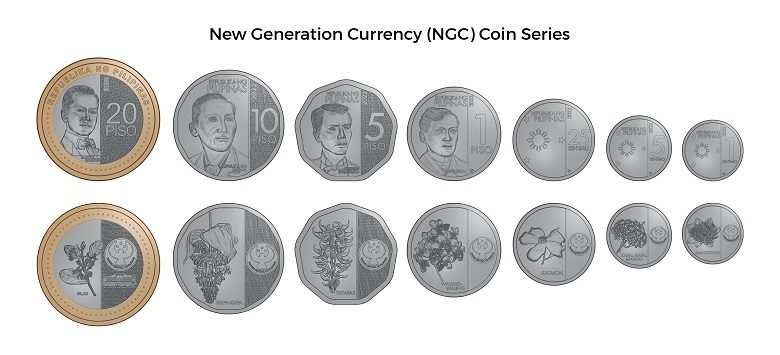
Philippine peso coins
Although cent coins are still legal, the truth is that they are not used on a day-to-day basis due to their low value and in the Philippines they try to round up prices.
Philippine peso banknotes
In 1995 a new set of coins and notes called the New Design Series was issued. In 2009, the Bangko Sentral ng Pilipinas announced the launch of a massive redesign of the banknotes with increased security and durability. The new banknote design features famous Filipinos and the country’s natural wonders.
Currently, the 1995 issue (New Design Series) banknotes and the 2009 New Generation Currency (NGC) coexist, the BSP deliberately retained some characteristics of NDS, such as size, predominant colors and prominent personalities in NGC, with the exception of the portrait of President Corazón Aquino, which is a portrait added to the 500-peso banknote.
The current new series began circulation on December 16, 2010. In 2020, the enhanced NGC banknotes for the elderly and the visually impaired saw the light of day, and feature the latest anti-counterfeiting technology. NGC and Enhanced NGC banknotes are legal tender and can be used as payment for goods and services.
Philippine peso banknotes in circulation have the following denominations: 20, 50, 100, 200, 500 and 1000 PHP.
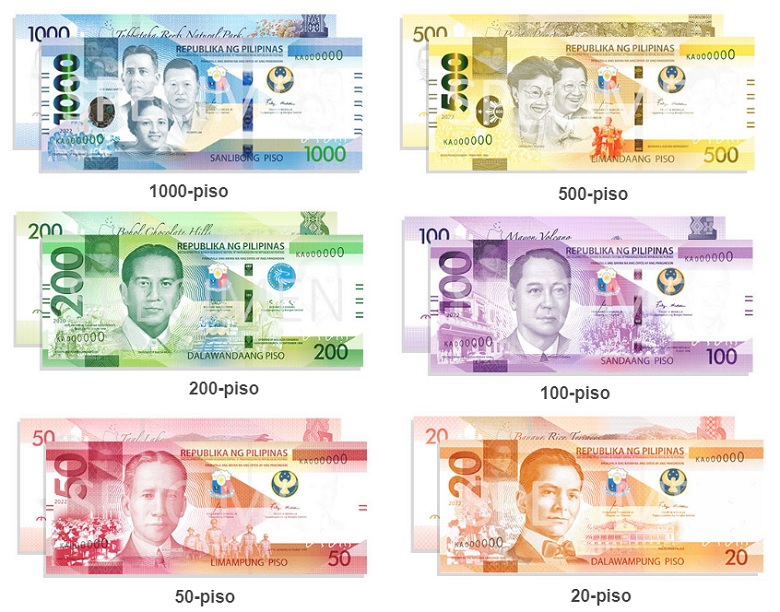
Philippine peso banknotes
20 peso banknote
Orange banknote that shows Manuel Luis Quezón Molina (1878-1944), lawyer, soldier and statesman who presided over the Commonwealth of the Philippines between 1935 and 1944 on the obverse next to the Malacañán Palace, official residence of the President of the Philippines, which is It is located on the north bank of the Pasig River in Manila.
The reverse shows the Banaue and Palm Civet Rice Terraces.
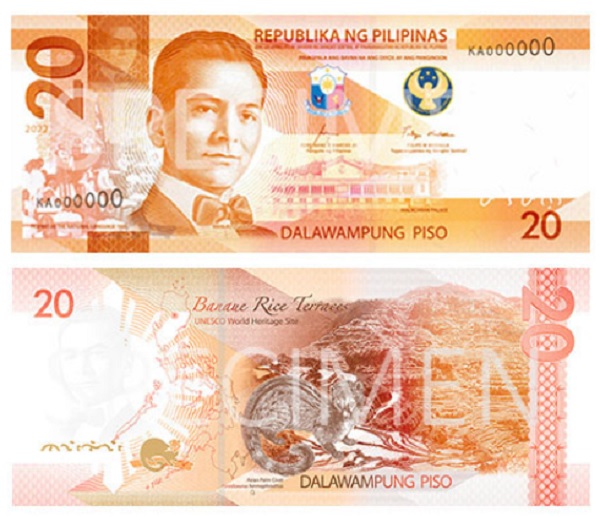
20 Philippine peso banknote (20 PHP)
This 20-peso banknote is exchanged in Spain in July 2023 for 28 euro cents.
50 peso banknote
Red colored banknote that shows Sergio Osmeña on the obverse together with an image of the first Assembly of the Philippines and the landing of Osmeña and General Douglas MacArthur in Leyte.
Osmeña (1878-1961), Filipino politician and lawyer, was vice president of the Philippines during the presidency of Manuel Quezón, upon whose death from tuberculosis in 1944 he assumed the presidency until May 1946. The reverse shows Taal Lake and the giant trevally.
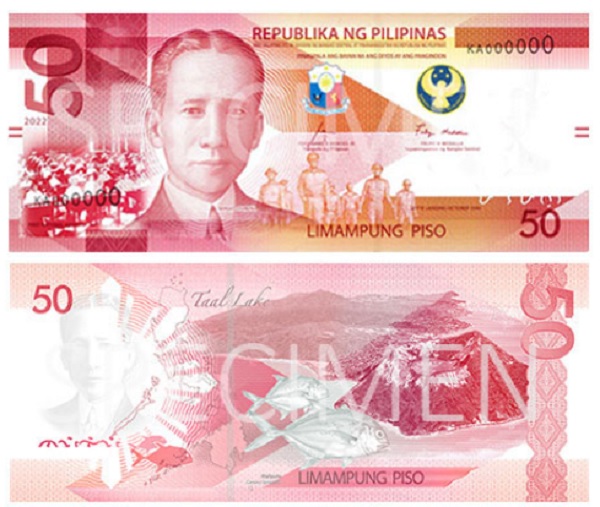
50 Philippine peso banknote (50 PHP)
This 50-peso banknote is exchanged in Spain in July 2023 for 71 euro cents.
100 peso banknote
Violet colored banknote showing Manuel Acuña Roxas (1892-1948) first President of the Republic of the Philippines on the obverse next to the former Central Bank of the Philippines (BSP) building, Manila and a scene of the inauguration of the Third Republic of Philippines.
The reverse shows the Mayon volcano in Albay and the whale shark (Rhincodon typus).
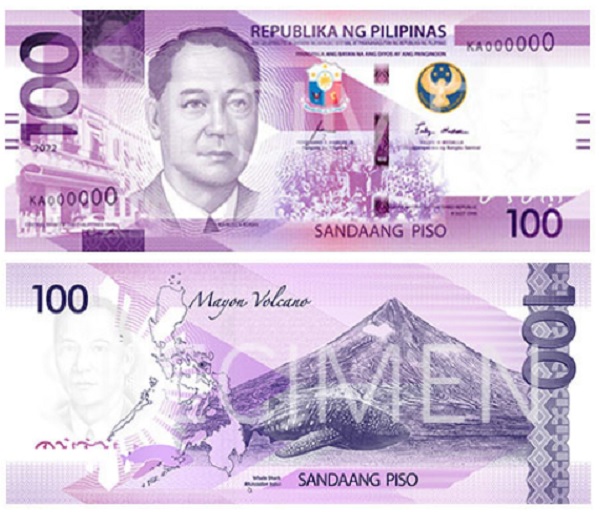
100 Philippine peso banknote (100 PHP)
This 100-peso banknote is exchanged in Spain in July 2023 for 1.41 euros.
200 peso banknote
Green banknote.
The obverse shows Diosdado Macapagal y Pangan (1910-1997), a Filipino politician, Vice President of the Philippines from 1957 to 1961, and President from 1961 to 1965. He was also the father of Gloria Macapagal Arroyo, President of the Philippines from 2001 to 2010. Also shows the EDSA People Power 2001, the Aguinaldo Sanctuary in Kawit (Cavite) and the Barasoain Church in Malolos (Bulacan).
The reverse shows the Philippine tarsier (Tarsius syrichta), a primate of the tarsiform species, and the Chocolate Hills in Bohol (about 1,268 equally-sized rock cones spread over an area of more than 50 square kilometers).
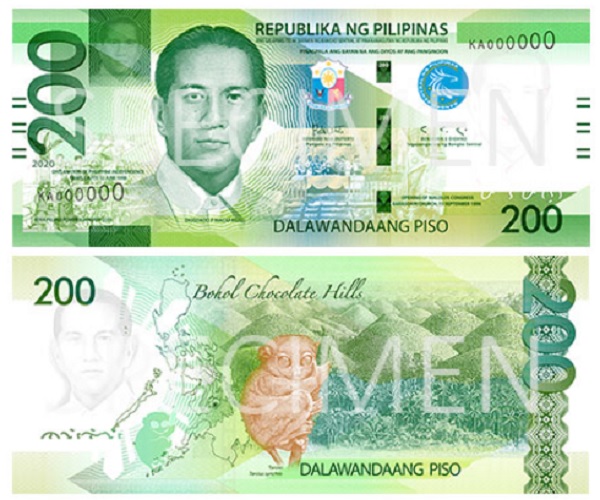
200 Philippine peso banknote (200 PHP)
This 200-peso banknote is exchanged in Spain in July 2023 for 2.83 euros.
500 peso banknote
Yellow banknote shows Corazon and Benigno Aquino Junior next to the Benigno Aquino Jr. (Ninoy Aquino) memorial in Makati City.
The reverse shows the Puerto Princesa (Palawan) underground river and a Philippine blue-naped parrot (Tanygnathus lucionensis) along with a fabric from the southern Philippines.
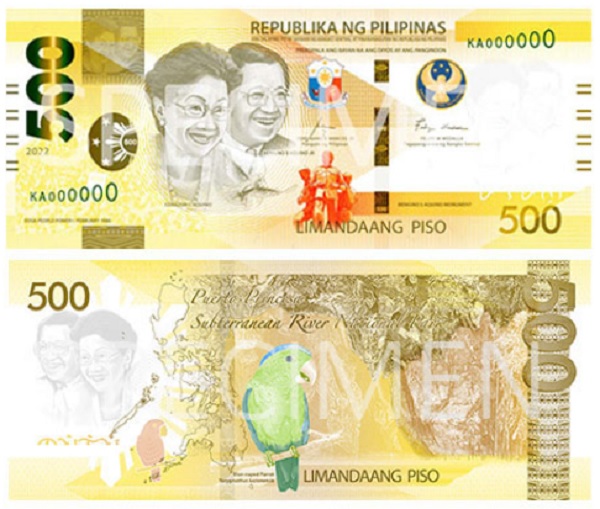
500 Philippine peso banknote (500 PHP)
This 500-peso banknote is exchanged in Spain in July 2023 for 7.07 euros.
1,000 peso banknote
Blue colored banknote that shows the faces of José Abad Santos (1886-1942), Vicente Lim (1888-1944) and Josefa Llanes Escoda (1898-1945), heroes during the Japanese occupation of the island in World War II, in the obverse. The reverse shows a southern sea pearl oyster (pinctada maxima) and Tubbataha Reefs Natural Park (Sulu Sea).
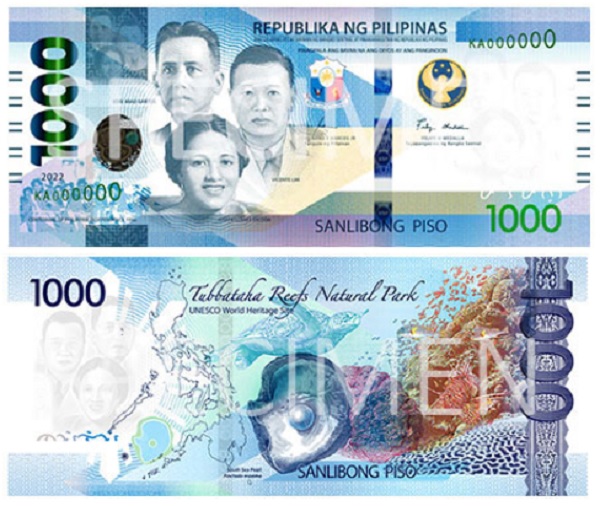
1000 Philippine peso banknote
The equivalent value of this 1000-peso banknote in euros would be around 14.13 euros, today, July 5, 2023.
Euro to Philippine peso exchange rate
The euro to Philippine peso exchange rate is continually changing. In the last 5 years and months, it shows a slight depreciation of the Philippine currency, in tune with the country’s economic ups and downs.
If you search on Google for “Philippine peso to euro exchange rate” you will find dozens of websites like Oanda (called “currency converters”) that offer a “rate” of the day, even with Google Finance prices.
Something like this (July 5, 2023):
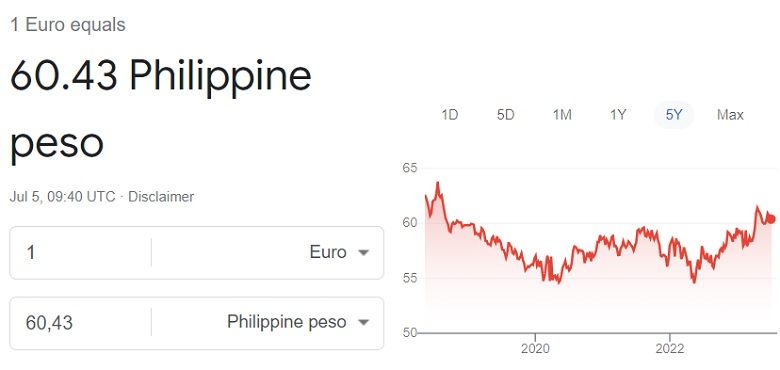
Euro to Philippine peso rate 5 July 2023
As you can see, the exchange rate for the last 5 years has fluctuated between 55 and 64 pesos for each euro, but keep in mind that this graph represents the value of the “currency” against the euro, and not that of the currency, which it’s lower.
In fact, in currency suppliers in Spain you can buy Philippine pesos at an exchange rate of between 50 from Cambiator and the 41 pesos for each euro that they would give you today at the airport. Nothing to do with the euro to peso currency exchange of 60.40 pesos per euro.
So, when you see these values in Google and other currency converters with your mobile, keep this in mind:
-This is an unreliable rate. In other words, if you click on the “Disclaimer” link, you get this warning from Google Finance: “Google cannot guarantee the accuracy of the exchange rates displayed. Please confirm current rates before making a transaction that may be affected by changes in exchange rates.”
-These rates you see are usually wholesale rates of the Philippine peso currency against the Euro currency (currency and banknotes we tourits use abroad are not the same);
-This rate can only be held by the banks among themselves (although in Spain none of the big banks sell or buy Philippine pesos), that is, it is impossible to get it as an individual.
If you need pesos in banknotes you will have to go through the banknote retail market (currency suppliers).
This market means that the Philippine currency has had to be “transported” by someone for you to enjoy it (or the pesos previously bought from Filipino tourists passing through Spain). In other words, moving notes from one place to another has logistical costs that will make their sale price more expensive (the exchange rate that will be applied by whoever sells them to you).
The Philippine peso is a rare and not very abundant currency in Spain, so it is not easy to find it available for sale. Therefore, it is good to anticipate the purchase and order it online at a currency supplier to obtain a better rate.
Where to exchange Philippine pesos in Spain
The exchange of Philippine pesos for euros can only be done in currency suppliers and in international transit areas such as airports. The big banks (Santander, BBVA, Caixa or Sabadell) do not market it, but if they did, they would charge you a commission of 2-3% plus an exchange rate, which is not very interesting.
Of these, the least recommended places to buy are airports (today they give you 41 euro pesos) and any business that charges you a commission in addition to an “exchange margin” (difference between the price for which you paid the currency and the price for which he sells it to you).
If you opt for a currency supplier keep in mind that in Spain you have “expensive” currency suppliers for being in airports and train stations (Global Exchange and Exact Change). And quite competitive suppliers with full guarantees such as the 8 that collaborate with Cambiator and are willing to measure themselves and compete with transparent rates.
Euro to Philippine peso exchange rate today
To know the Euro to Philippine peso exchange rate, discover the usefulness of our currency comparator (free for you):
- Euro to Philippine peso rate (EUR-PHP)
- Philippine peso to Euro rate (PHP-EUR)
Other popular currencies
Best rate of the day (exchange euros to another currency)

Sin comentarios